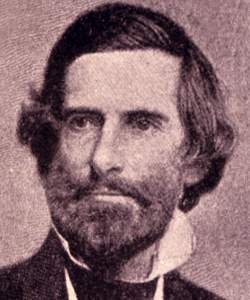Samuel Gridley Howe (American National Biography)
Scholarship
Armed with equal education ideals, he believed that the blind should no longer be doomed to inequality, to becoming only "mere objects of pity." During his first years as director [of the Perkins Institution for the Blind], he visited seventeen states, establishing schools in Ohio, Tennessee, Kentucky, and Virginia. He also developed an embossed-letter system for the blind to read, first known as Howe Type, and later as Boston Line Type. It was used at Perkins until Braille came into common usage at the turn of the century.
In 1837 Howe began an experiment in education that would bring him to the attention of the world, that of educating Laura Bridgman, a girl who had become deaf-blind from scarlet fever at the age of two. His success in educating her proved that it was possible to educate a deaf-blind person…
In 1848 he started the first public institution in the United States to educate the mentally retarded. He also became involved in deaf education, helping to establish the Clarke Institution for Deaf Mutes (now the Clarke School for the Deaf) in Northampton, Massachusetts, in 1867. He has rightly been called the most significant and foresighted figure in the American history of special education. He also participated in the reform of public school education with Horace Mann, in prison reform, in helping the mentally ill with Dorothea Dix, and in the antislavery movement.
In 1837 Howe began an experiment in education that would bring him to the attention of the world, that of educating Laura Bridgman, a girl who had become deaf-blind from scarlet fever at the age of two. His success in educating her proved that it was possible to educate a deaf-blind person…
In 1848 he started the first public institution in the United States to educate the mentally retarded. He also became involved in deaf education, helping to establish the Clarke Institution for Deaf Mutes (now the Clarke School for the Deaf) in Northampton, Massachusetts, in 1867. He has rightly been called the most significant and foresighted figure in the American history of special education. He also participated in the reform of public school education with Horace Mann, in prison reform, in helping the mentally ill with Dorothea Dix, and in the antislavery movement.
Kenneth Stuckey, "Howe, Samuel Gridley," American National Biography Online, February 2000, http://www.anb.org/articles/15/15-00349.html.





